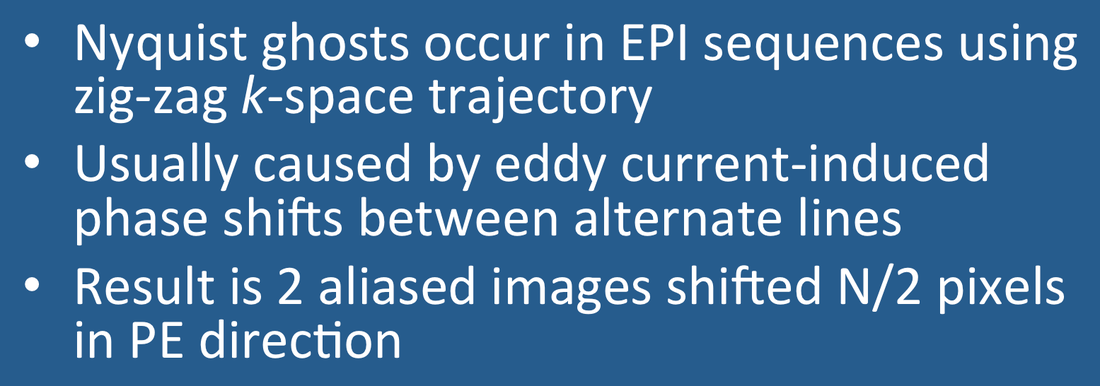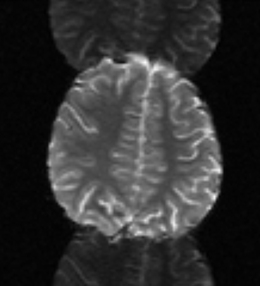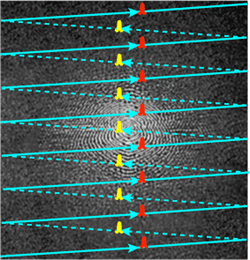|
The artifact you are describing is called the Nyquist N/2 Ghost. It occurs with echo-planar imaging sequences that have a zig-zag trajectory through k-space. In head MRI it is sometimes referred to as the "Three Brains Artifact".
EPI pulse sequences are composed of a train of echoes, one echo generated for each line of k-space traversed. In zig-zag acquisition, every second echo is acquired in an alternate direction. For image reconstruction, even numbered echoes must be time-reversed so that match the odd numbered echoes before Fourier transformation.
|
|
If the forward and backward echoes are not perfect mirror images of each other, then artifacts are introduced into the image processing. Even a simple delay of the start of the first echo will be propagated into all later echoes resulting in slight timing differences between the peaks of odd- and even-numbered echoes. When the Fourier transform is performed, this phase error results in signal intensity displaced in the phase-encode direction halfway across the image. If there are N pixels across the FOV, this aliased ghost appears shifted N/2 pixels relative to the main image positioned at the correct location.
|
Nyquist ghosts can result from many possible sources including poor shimming, gradient coil heating, patient motion, receiver filter asymmetry, susceptibility, and reconstruction errors. The most common cause, however, is the induction of eddy currents in coils and the magnet housing in response to rapidly changing gradient pulses. These eddy currents, in turn, produce local fields that distort Bo and add phase shifts to the data. The even- and odd-numbered lines have oppositely directed readout gradients. This means that alternate lines will have opposite eddy-current-induced phase shifts.
Using oblique slices may also contribute to the production of Nyquist N/2 ghosts. Oblique imaging requires simultaneous application of the three physical gradients (Gx, Gy, and Gz) in various mixtures throughout image acquisition. However, each physical gradient has a unique electrical inductance and responds differently to being switched on and off. If the three gradients do not activate and deactivate at exactly the same time, phase errors may occur. Sometimes simply adjusting slice obliquity (either more or less) will reduce the Nyquist ghosts.
Other methods to reduce Nyquist N/2 ghosts include re-shimming, reducing echo train length, lowering the phase-encoding resolution, avoiding multi-shot (segmented) EPI, and employing parallel imaging acceleration. If these methods do not work and the artifact persists over multiple subjects, then more extensive servicing by an engineer to recalibrate the gradients and eddy current compensation may be required.
Advanced Discussion (show/hide)»
N/2 ghost correction is now usually automated and invisible to the user. However, options exist on some scanners for large array (32+channel) coils where local instabilities may cause ghost-correction algorithms to fail.
An EPI pulse sequence called fly-back EPIfly-back EPI uses all positive or all negative readout gradients, eliminating zig-zag phase errors, and is N/2-ghost free. However, fly-back EPI places much higher demands on gradients and switching rate is limited because of peripheral nerve stimulation. Additionally, because the time interval between readout periods is increased, increasing spatial distortion is traded for the elimination of N/2 ghosts.
References
Buonocore MH, Gao L. Ghost artifact reduction for echo planar imaging using image phase correction. Magn Reson Med 1997; 38:89-100.
Reeder SB, Atalar E, Bolster Jr BD, McVeigh ER. Quantification and reduction of ghosting artifacts in interleaved echo-planar imaging. Magn Reson Med 1997; 38:429-439.
Yang QX, Posse S, Le Bihan D, Smith MB. Double-sampled echo-planar imaging at 3 Tesla. J Magn Reson 1996; 113:145-150.
Buonocore MH, Gao L. Ghost artifact reduction for echo planar imaging using image phase correction. Magn Reson Med 1997; 38:89-100.
Reeder SB, Atalar E, Bolster Jr BD, McVeigh ER. Quantification and reduction of ghosting artifacts in interleaved echo-planar imaging. Magn Reson Med 1997; 38:429-439.
Yang QX, Posse S, Le Bihan D, Smith MB. Double-sampled echo-planar imaging at 3 Tesla. J Magn Reson 1996; 113:145-150.


